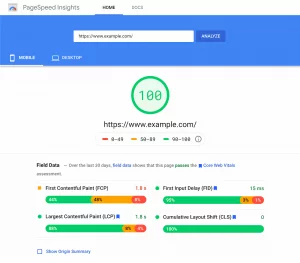Thanks to its solid codebase, WordPress errors are rare, but when they do occur, they are often straightforward to identify. One such error is the 414 Request URI Too Large issue, which indicates that the requested URL is too lengthy for the server to process. To fix 414 Request, there are several steps you can take to resolve the issue.
The root cause of the 414 error is that the URL exceeds the server’s configured limit for the URI (Uniform Resource Identifier). This often happens when a URL becomes too long due to excessive query parameters, redirects, or the structure of a permalink.
In this guide, we’ll walk you through how to fix the 414 Request URI Too Large error. You’ll learn what tools and knowledge you’ll need to tackle the issue, along with some preparatory steps to take before diving into the solution. With the right approach, you’ll be able to resolve this problem efficiently and get your website back on track.
What is 414 Request URI Too Long Error?
The 414 Request URI Too Long error is a specific HTTP status code that occurs when a client, such as a web browser, app, or other HTTP client, sends a request to the server with a URL (Uniform Resource Identifier) that is too long for the server to process. The URL is the web address being requested, and the error essentially means that the server cannot handle the length of the URI sent to it.
When does the 414 Request URI Too Long Error Occur?
This error happens when the URL you’re trying to access surpasses the size limit set by the web server. Different servers have different default settings, but typically the maximum length of a URI that most servers can handle is around 8,000 characters.
When this limit is exceeded, the server can no longer interpret the URL properly, and it returns the 414 Request URI Too Long error.
Typical Error Messages You Might Encounter:
- HTTP Error 414: Request-URI Too Long
- 414 Request-URI Too Long
- The requested URL’s length exceeds the capacity limit for this server.
These messages are essentially the server’s way of indicating that it can’t process the request because the URL is too large. In simpler terms, the request is beyond the server’s capacity to handle.
What is the Cause of 414 Request URI Too Long Error?
1. Long Query Strings or Parameters
URLs often include query strings to send data to the server. These query strings appear after the question mark (?) in the URL and contain key-value pairs separated by an ampersand (&). For example:
arduinoCopyhttps://www.example.com/products?category=electronics&color=blue&price_range=100-500&size=medium
Each additional parameter in the query string increases the URL length. While passing data in this manner is common on search pages, eCommerce websites with filtering systems, and form submissions, if too many parameters are included, the URL can become too long for the server to process. This is particularly problematic when large amounts of data are included in the query string, as it may easily exceed the server’s limit for URL length.
2. Misconfigured URL or Redirect Loops
Another common cause of the 414 Request URI Too Long error is a misconfigured URL or an infinite redirect loop. In such cases, a URL structure is mistakenly set up in such a way that it keeps appending parameters or components to the URL without end. This can lead to an infinitely growing URL that surpasses the server’s handling capacity.
For example, when a server keeps redirecting a URL to itself, each redirect might add a new query parameter or piece of information to the URL. This causes the URL to grow longer with each iteration, eventually resulting in a 414 error.
3. Excessive Tracking Parameters
Many websites incorporate tracking systems that append lengthy query parameters to URLs for purposes such as analytics, advertising, or marketing. These parameters help track user behavior, conversions, or other metrics. While they are useful for data collection, they can significantly bloat the URL, especially when multiple tracking systems or tools are being used together.
For example, marketing campaigns might append tracking tags like:
arduinoCopyhttps://www.example.com?utm_source=facebook&utm_campaign=spring_sale&utm_medium=banner
As more systems or campaigns stack on additional parameters, the URL becomes increasingly long, which can lead to the 414 Request URI Too Long error if the server can’t process such a long string.
4. WordPress Plugins or Themes
On WordPress sites, certain plugins or themes may generate long URLs, especially when dealing with dynamic content like searches, filtering, or personalized data. For instance, search and filter plugins that allow users to refine content results can generate URLs that contain numerous parameters. Similarly, poorly configured plugins, such as those handling redirects or custom post types, can unintentionally add extra, unnecessary information to URLs, making them too long.
Additionally, URL rewrites or tracking plugins might inadvertently create complex URLs by appending or rewriting URLs in a manner that results in excessive length. These kinds of issues are more likely to occur when plugins or themes are not optimized or configured correctly.
5. Improper Customization or Poorly Designed URLs
In some cases, custom-designed websites or web applications may have improperly structured URLs that unintentionally grow too long. When URLs are generated dynamically—often through code customization—a poorly designed URL structure can cause the URL to become excessively lengthy without much oversight.
For example, a website might dynamically generate URLs with too many unnecessary parameters or values that aren’t required for the requested page, making the URL far longer than necessary. Without the right checks or limitations in place, these URLs can become too long for the server to handle, triggering the 414 Request URI Too Long error.
Fix 414 Request-URI Too Large Error: Your Quick Fix Guide
Once you have gathered your tools, it’s time to come up with a plan. Fixing the 414 Request-URI Too Large error involves tweaking a server configuration file. Here’s a simple three-step process you can follow:
Step 1: Login to Your Server (and Choose the Type of Server you Want to Use).
The first step in fixing the 414 Request-URI Too Large error is to log into your server. You’ll need access to the server’s configuration files, which you can modify to adjust the URI length limits. You’ll also need to determine which type of server you are using—Apache or Nginx—since the solution differs based on the server type.
- For Apache servers, you can typically identify the server by the presence of the
.htaccessfile in the root directory. - For Nginx servers, you won’t find a
.htaccessfile, and the configuration file will be located elsewhere.
If you’re unsure about which server type you have, there are several ways to identify it:
- Use a domain lookup tool like WhatIsMyIP or Site24x7.
- Alternatively, you can simply contact your hosting provider and ask them to confirm the type of server you’re using.
Once you’ve identified the server type, you can proceed with accessing the correct configuration file.
Step 2: Locate and Open the Server Configuration File in Your Text Editor.
Once you’ve logged into your server and identified the server type, the next step is to find the relevant configuration file.
- For Apache servers, the main configuration file is generally located in the
/etc/apache2/apache2.confdirectory. This file is where the server settings are defined, including limits on the request URI length. - For Nginx servers, the configuration file is typically found in
/etc/nginx/nginx.conf.
To access these files, you will need to use a Secure File Transfer Protocol (SFTP) client, such as FileZilla, WinSCP, or an SSH terminal for command-line access. Here’s how you can proceed:
- Use your SFTP client to connect to your server.
- Navigate to the appropriate directory (
/etc/apache2/for Apache or/etc/nginx/for Nginx). - Download the configuration file to your local machine for editing.
Once the configuration file is downloaded, open it in a text editor (such as Notepad++, Sublime Text, or Visual Studio Code). You’re now ready to modify the file.
Step 3: Adjust the Configuration File To Allow for Longer URLs
Now that you have the server configuration file open, you need to adjust the settings that control the maximum URL length.
- For Apache servers, locate the
LimitRequestLinedirective. This setting controls the maximum length of a request line, which includes the URL. By default, Apache might restrict the request line to a smaller value, causing the 414 error. To resolve this, increase theLimitRequestLinevalue.- Find the
LimitRequestLineline in the configuration file. - Set the value to at least 128000 (which allows for larger URLs). If you’re still encountering the error, increase the value in multiples of two until the error is resolved.
- Find the
Example configuration:
LimitRequestLine 128000
- For Nginx servers, locate the
large_client_header_buffersdirective. This setting determines how large the client request headers (including the URI) can be before they are rejected. You’ll need to increase the size of the buffers to allow for longer URLs.- Find the
large_client_header_buffersline in the Nginx configuration file. - Modify the size value to accommodate larger URLs (e.g.,
8 128kor higher).
- Find the
Example configuration:
large_client_header_buffers 4 16k;
After making these adjustments, save the file and upload it back to the server, overwriting the existing configuration file.
Step 4: Restart the Server
Once you’ve saved and uploaded the modified configuration file, the final step is to restart the server to apply the changes. This ensures that the new settings take effect.
- For Apache, you can restart the server using the following command:
sudo service apache2 restart
- For Nginx, restart the server with this command:
sudo service nginx restart
After restarting the server, your changes will be applied, and the 414 Request-URI Too Large error should be resolved. You can now test your website again to see if the issue persists.
Also read: 7 URL Shorteners to Elevate Your SEO Strategy and Enhance User Experience
No Risk, Just Reward – Get Your Website Back on Track by Fixing the 414 Error
By tweaking your WordPress settings and server configurations, you can easily fix 414 Request issues. Whether it’s simplifying permalinks, reducing query parameters, or adjusting PHP and server limits, these steps will help prevent the error from disrupting your site. If the problem persists, reaching out to your hosting provider can offer additional solutions. With a little attention to these details, you’ll have your site back to running smoothly in no time.
Ready to experience hassle-free hosting? Sign up for a free trial with Nestify Hosting and enjoy top-tier performance, exceptional support, and easy-to-use features.
Claim your free trial now and take your website to the next level with Nestify Hosting!
FAQs on 414 Request – URI Too Long Error
How can I determine my server type?
You can usually determine your server type by checking for specific configuration files. For Apache servers, look for a .htaccess file in the root directory. For Nginx servers, the configuration file is typically located in /etc/nginx/nginx.conf.
What adjustments can I make to the server configuration file?
Depending on your server type, you may need to adjust settings such as LimitRequestLine for Apache servers and large_client_header_buffers for Nginx servers. Increasing these values can help accommodate longer URLs and prevent the 414 error.
How do I know if the error has been resolved?
After making adjustments to the server configuration file, you can test your website to see if the 414 error persists. If the error no longer occurs when accessing long URLs, it indicates that the issue has been successfully resolved.



